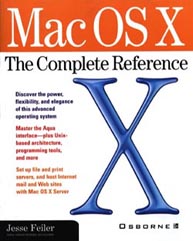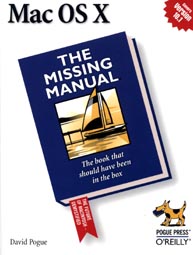eXtensions
|
Macintosh OS X: A Tome, a Terrific Read and a Work in Thai
|
By Graham K. Rogers
|
|
Feiler, Jesse.; OS X: The Complete Reference;
Osborne, NY: 2001.
Available: Kinokuniya Books (World Trade Center),
1811 baht.
|

|
|
|
Pogue, David OS X: The Missing Manual. Pogue
Press/O'Reilly, Sebastopol, CA; 2002.
Available: The Apple Shop,1390 baht.
|

|
|
|
Mac OS X.
IEQ (Thailand) Institute, Bangkok; 2001.
Available: The Apple Shop,299 baht.
|

|
When you start up Apple's OS X (Ten not x), you may be forgiven for thinking
you are on familiar territory. Do not be fooled.
The first time I went past the startup screens, I stopped and switched
back to OS 9 a.s.a.p.. I had been using varieties of System 8 for a couple
of years and there was nothing alien about 9, especially once I had installed
my favourite software. OS X is not simply a new flavour, it is a new species.
It is a hybrid: a graphic interface, on top of the UNIX operating system
developed for NeXT.
Users new and old, we all need some help.
The three books under review are all useful in different ways.
Feiler's, The Complete Reference is just that. It is not a joyous
read. For the purposes of getting to grips with OS X, I did read right through
it. It is adequate. It has the bare facts (a little too bare in some sections):
some items were listed with bare explanations of what they are. A novice
would need much more.
It belongs on the bookshelves of academic departments along with all those
other computer reference books.
To be fair to Feiler and his team, the book was published in 2001 while
the OS was either being developed or was just finished. There have since
been updates to OS X, although some local dealers seem unaware of this.
It is one of the works advertised on Apple's own excellent website.
Of particular value are sections in Chapter 1 and Chapter 3 which explain
system architectures. This is probably the first time that this has made
sense in my non-technical mind.
I found somewhat cloying the continued references to how wonderful or
innovative OS X is. Having used it for a month or so, OS X is proof enough
and I do not envisage switching back to earlier systems. The book feels
very "party-line" Apple.
I was surprised in such a high quality publication to see the error of
"weather" instead of "whether" and wonder how many pairs of eyes missed that.
It is generous with illustrations, and Feiler uses these well to complement
the text. By reading a section and then working on the computer, it was
all (in the main) clear. There were no surprises. The Complete Reference
showed me exactly what I could expect to see.
Other useful sections were those on Networking and on using Applescript
-- the Macintosh macro; and on using the command line. This may seem somewhat
odd from the company that pioneered computers with no command line, but Apple
giveth while Microsoft taketh away. It is intended to give the OS maximum
tunability. I must admit that it was handy last week when I had a network
problem and was able to telnet to another system to track down a solution
-- real UNIX. I haven't done that in a while.
If The Complete Reference belongs in a system administrator's bookcase,
David Pogue's friendly book belongs on every Mac owner's desk, or table,
or floor -- depending on where you use your computer. I had seen sections
of this work reproduced in Macworld, but their website was orgranised
in such a way that I could not find how to order it; and the publisher's
website showed "out of stock." I left my details. A few days later I found
it in the smart (but small) Apple shop in the Siam Discovery Center. When
I got into work the following Monday, however, there was another copy of
Pogue's book, so now I have one for the office and one for home.
I had bought a similar book, What Microsoft Left out of Windows 3.1
(yes, that long ago), mainly because of the floppy disk that was inserted
into the back cover. Pogue's book has no floppy disk, of course -- Macs
do not use these nowadays -- but nor does it have a CDROM. Instead all of
the software mentioned in the pages is available for download from
where you click, "Missing CD ROM."
Within minutes of opening the book, I found I had fingers inserted in
three separate chapters. The book is not badly orgranised, it just had so
much in it I wanted to find out. While checking one item, I would find a
parenthetic reference to another.
Pogue is a clear writer. He is a little impish at times. There is none
of the reverence found in The Complete Reference : if the latter is
"party-line" then Pogue's work is anarchy. But then neither book is intended
to do the same task. Feiler informs and instructs, while Pogue educates
and entertains.
I wish I had read this before starting OS X. I soon realised what I should
have done, and why; and I discovered some really unusual things. You should
see what you can now do with the simple "Stickies" utility, for example.
Many text panels in the book are inserted into the text and are black
with white text. Each contains a tip or a text explanation that is allied
to the main theme of that particular chapter. These are littered throughout
the book.
Some of the most significant software is also highlighted, particularly
i-Tunes and i-Movies. i-Photo has only just been released and is also included.
I had picked up the 3rd printing (there were 4 in February alone) and
the website indicates there have been 7 (the copy that came in the mail).
The Feiler work was up to its 4th printing when I checked.
Also on the shelves of the Apple Store were a couple of books on OS X
written in Thai, at very reasonable prices. I picked up the cheapest; not
because it was cheap but because of its size: it would make a useful pocket
reference for someone fresh to OS X.
IEQ have put together a nice little starter. It is obvious from the ilustrations
that this is an original work although there is perhaps a little too much
information for IEQ's good: they include account names and login details
(but not a password -- it does have 8 characters though). The book refers
to version 10.0 and 9.1 Pogue manages to get up to 10.1. The current versions
are 9.2.2 and 10.1.3.
As is to be expected in a book about computing, English must be included,
even when the explanations are in another language (in this case Thai).
Writers who include English should get someone to proof read. The few examples
I found should not detract from the understanding of a Thai reader.
These three quite different books are all available in Bangok now (or
via the Internet of course). Each is useful in its own way: as a reference,
for the power user, and for an introduction in Thai. If I were to be restricted
to one, I would take The Missing Manual, not least for its entertainment
value. When did you last read a computer book that made you smile?
For further information, e-mail
to Graham K. Rogers.
Back to
eXtensions
Back to homepage


